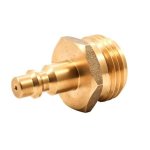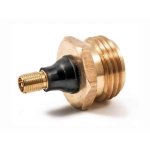If you're going to use compressed air for this, I have a few suggestions. I am NOT an expert but just sharing the process that works for me.
First, you want the valve that has a schrader-style (bicycle/car tire) valve on one side and 3/4 GHT (garden hose thread) on the other. There are a million of these on Amazon and they're all the same. This is what mine looks like:
Next, you want an air compressor with a long enough hose to reach the valve when it's installed on your city water inlet port. If you have an adjustable one and can set it to 35-40 psi that's ideal but not necessary. A "tire inflator" like the kind you find cheaply at Walmart or in car emergency kits WILL NOT work. You're looking for volume, not pressure, so ideally something with a tank, no matter how small.
Given the above here's my process:
1. Adjust bypass valves behind HWH. Usually there are three - you close a pair of valves on the HWH inlet and outlet, and open a valve usually on a short bypass between the inlet/outlet, bypassing the HWH.
2. Remove anode and drain HWH. Inspect anode, order new one if <50% left. They can go until they're just a wire left, but they're cheap. Why risk it.
3. Reinsert anode into HWH hole loosely, to keep bugs out (and to keep it clean).
4. Remove shower heads and let their hoses dangle (shower heads are really hard to blow out completely and their hoses trap water).
5. Connect and turn on air compressor. Set to 35-40psi. If this is not doable, open one faucet somewhere before turning it on.
6. Open each faucet cold then hot one at a time. After the water is nearly all out, turn it off and count to 10 then open it again. Repeat until only air comes out.
7. Do this for each faucet. Don't forget your outdoor shower and outdoor kitchen if you have one. And don't forget the toilets!
8. Go back around one last time.
9. Shut off air compressor.
10. Open all low point drains, and turn on one faucet in the camper. Let gravity do its thing.
11. Remove and empty the filter bowl on the water pump. While it's off, tilt the pump a bit to get out any remaining water.
12. Dump black and grey tanks.
13. Pour pink antifreeze into each sink, enough to fill each trap.
14. Pour half of whatever's left over into each toilet, and flush. This gets antifreeze down to the gate valve under the tank, helping protect it.
15. Close low point drains (bugs).
In spring I run a quarter bottle of RV water system sanitizer through the fresh tank with the first fillup. I've never had a problem, but maybe it's because I never skip this step.
It sounds like a long list but I can winterize my camper in <10 min. I make no promises for your own use, but I've never had a line or faucet develop a leak using this method. There are plenty of fans of "pink stuff everywhere" and that's probably the safest answer in the long run, but IMO this is actually faster, uses less antifreeze to winterize, and wastes less water later when you have to flush out your lines in spring. YMMV.
Bear in mind: it's not necessary to get every droplet of water out of the system. What damages water systems when they freeze isn't just the
presence of water, it's that water having nowhere to
expand into. Try this. Take two plastic water bottles. Fill one COMPLETELY to the top and close its cap tightly. Fill the other one to 90% - just an inch or so of air space. Now freeze both. The completely full bottle (simulating a full water system) will burst (or at least expand and make it very obvious this was a bad idea). The one filled to 90% will not.
Water expands about 9% when it freezes. If there is air space for it to do that, it won't break anything. That's why it's so crucial to get it out of tight spaces (full water lines, the HWH, faucets/shower heads) because those don't normally have extra space for it to expand into. But if there is a small amount left in your lines, let's say because there's some low point, that won't hurt anything. It will be able to expand left/right along the water line. You just need to get the majority of it out.


